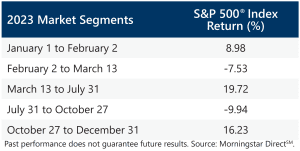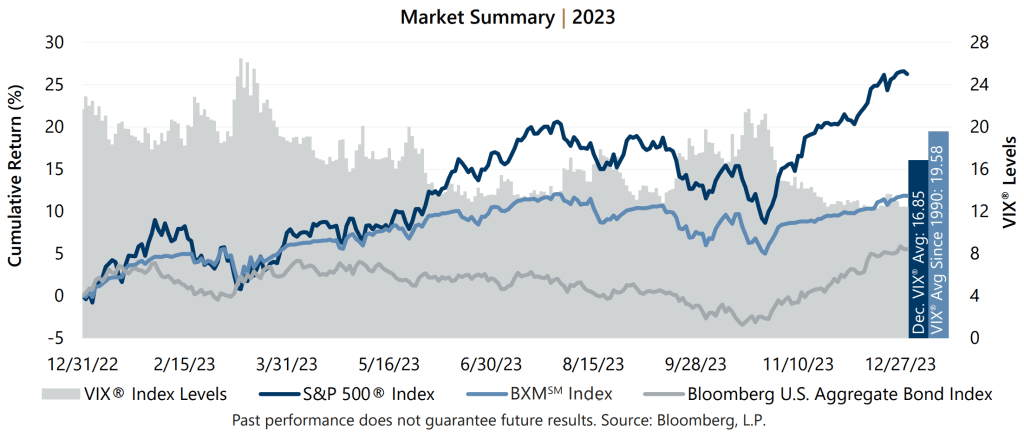The S&P 500® Index returned 11.69% in the fourth quarter of 2023, with monthly returns of -2.10%, 9.13%, and 4.54% in October, November, and December, respectively. The strong quarterly advance brought the S&P 500® Index’s 2023 return to 26.29%. The quarter began on a negative note with monetary policy unclear and conflict erupting abroad. The equity market extended a decline that started in the third quarter and ended with a new 2023 maximum drawdown. From July 31 through October 27, the equity market declined 9.94%. A change in tone at the U.S. Federal Reserve (the Fed) and a continued easing of inflation fueled a rally through year-end. From October 27 through year-end, the S&P 500® Index climbed an impressive 16.23%.

Data released during December continued to reflect a strong economy and resilient labor market. The final estimate of Gross Domestic Product for the third quarter of 2023 showed that the U.S. grew by an annualized rate of 4.9%, missing expectations and revised downward from the prior estimate. The December unemployment rate of 3.7% was an improvement over November data and better than the consensus estimate, both of which were 3.9%. The participation rate ticked up to 62.8%. The November Consumer Price Index, released December 12, showed a year-over-year increase of 3.1%, which matched expectations. On the corporate earnings front, third-quarter aggregate operating earnings were on track to climb less than 1% quarter-over-quarter and just over 3% year-over-year. With more than 99% of S&P 500® Index companies reporting, over 83% met or exceeded analyst estimates.
 The S&P 500® Index returned 7.50%, 8.74%, -3.27%, and 11.69% in the first, second, third, and fourth quarters of 2023, respectively. Despite significant turmoil and conflict across the globe, the year was all about the Fed and expectations surrounding monetary policy. Investors deconstructed economic results and forecasts in an effort to predict the direction of policy and, most importantly, the level and pace of interest rate increases. After record inflation and negative equity markets in 2022, signs of softening inflation in January 2023 generated a feeling of hope from investors before reality realigned expectations. Several regional banks facing pressure from sudden and significant rate increases collapsed or required rescue. As confidence in the financial system showed signs of deterioration, the Fed enacted emergency measures which helped drive a significant rally in the S&P 500® Index. Last-minute negotiations around the U.S. debt ceiling helped trigger a surprise U.S. credit downgrade by Fitch Ratings and a second wave of regional bank downgrades. The sudden uncertainty contributed to a significant equity market decline from the end of July through October 27 before the market advanced through year-end as a feeling of hope for the new year sprouted, once again.
The S&P 500® Index returned 7.50%, 8.74%, -3.27%, and 11.69% in the first, second, third, and fourth quarters of 2023, respectively. Despite significant turmoil and conflict across the globe, the year was all about the Fed and expectations surrounding monetary policy. Investors deconstructed economic results and forecasts in an effort to predict the direction of policy and, most importantly, the level and pace of interest rate increases. After record inflation and negative equity markets in 2022, signs of softening inflation in January 2023 generated a feeling of hope from investors before reality realigned expectations. Several regional banks facing pressure from sudden and significant rate increases collapsed or required rescue. As confidence in the financial system showed signs of deterioration, the Fed enacted emergency measures which helped drive a significant rally in the S&P 500® Index. Last-minute negotiations around the U.S. debt ceiling helped trigger a surprise U.S. credit downgrade by Fitch Ratings and a second wave of regional bank downgrades. The sudden uncertainty contributed to a significant equity market decline from the end of July through October 27 before the market advanced through year-end as a feeling of hope for the new year sprouted, once again.
As typical with the equity market advancing significantly during 2023, implied volatility drifted lower. Implied volatility, as measured by the Cboe® Volatility Index (the VIX®), ended 2022 at 21.67 and averaged 16.85 during 2023. Consistent with its typical relationship, average implied volatility exceeded realized volatility, as measured by the standard deviation of daily returns for the S&P 500® Index, which was 13.10% for the year. The Volatility Risk Premium, or the difference between the two volatility measures, was positive throughout the year and averaged 4.19% in 2023, above the since-1990 average of 4.08%.
The VIX® spent most of 2023 ranging from the mid-teens to the mid-20s, closing above its long-term average of 19.58 for more than 20% of the year. The VIX® reached an intra-year high of 26.52 on March 13 at the height of the banking crisis before settling into a quiet summer supported by an outstanding equity market rally and optimism surrounding the path of interest rates. The selloff from July 31 through October 27 drove the measure higher, reaching a fourth quarter high of 21.71 on October 20. Implied volatility during the end of 2023 was stifled as hopes grew for an extended pause, or even cut, in interest rates. The VIX® reached an intra-year low of 12.07 on December 12 and ended 2023 at 12.45.

The Cboe® S&P 500 BuyWriteSM Index1 (the BXMSM) returned 4.19% in the fourth quarter of 2023, trailing the rapid ascent of the S&P 500® Index and bringing its full year return to 11.82%. The BXMSM returned -0.68%, 2.89% and 1.95% in October, November, and December, respectively. The premiums the BXMSM collected as a percentage of the BXM’sSM underlying value were 2.21%, 1.37% and 1.43% in October, November, and December, respectively. The premiums the BXMSM collected as a percentage of its underlying value provided significant loss mitigation during October’s decline but were insufficient to keep pace with the rapid rise of the market during the remainder of the quarter.
The BXMSM is a hypothetical S&P 500® Index buy-write strategy which purchases (buys) an equity portfolio replicating the S&P 500® Index and sells (writes) a single one-month S&P 500® Index call option with a strike price approximately at-the-money. On the third Friday of each month, the BXMSM writes a new index call option as the option it wrote the previous month expires. This passive, rules-based approach makes the BXMSM return subject to the equity market’s path, and the premiums that the BXMSM collects on its written index call options have significant influence on its return potential.
The performance of the BXMSM exhibits both the importance of cash flow generation and potential challenges of a passive approach to options-based investing. During periods of market stress in 2023, premiums collected reflected heightened levels of volatility and provided a source of downside protection. For instance, during the 7.53% decline of the S&P 500® Index from February 2 to March 13, the BXMSM provided 475 basis points (bps) of downside protection with a return of -2.78%. Again, during the 9.94% decline in the S&P 500® Index from July 31 to October 27, the BXMSM provided 364 bps of loss mitigation with a return of -6.30%. However, the passive approach of the BXMSM results in varying levels of market exposure which has the potential to provide loss mitigation but also inhibits participation in any sudden market advance. For instance, as the equity market quickly advanced from October 27 through year-end, the BXM’sSM passive approach led to relatively low market exposure and resulted in a 6.50% return compared to the 16.23% return of the S&P 500® Index.
The Bloomberg U.S. Aggregate Bond Index (the Agg) returned 6.82% in the fourth quarter of 2023, resulting in a return of 5.53% for the year – the Agg’s first positive annual return since 2020. The gain in the Agg was propelled by declining bond market yields and growing expectations of softening monetary policy in 2024. The Agg returned 2.96%, -0.84%, and -3.23% in the first, second, and third quarters of 2023. The annual gain for the Agg helped to recover a portion of the losses experienced during 2022, in which the Index lost 13.01%. The yield on the 10-year U.S. Treasury Note (the 10-year) ended 2022 at 3.87% and reached a 2023 low of 3.31% in early April. The yield on the 10-year climbed to an intra-year high of 4.99% on October 19 before a significant decline that took the Agg nearly to where it started, closing the year at 3.88%. The yield curve steepened significantly during the year and, in a continuation of a historical yield curve inversion that has persisted since July 5, 2022, the yield on the 2-year U.S. Treasury Note exceeded that of the 10-year for all of 2023.
1The BXMSM is a passive total return index designed to track the performance of a hypothetical buy-write strategy on the S&P 500® Index. The construction methodology of the index includes buying an equity portfolio replicating the holdings of the S&P 500® Index and selling a single one-month S&P 500® Index call option with a strike price approximately at-the-money each month on the Friday of the standard index-option expiration cycle and holding that position until the next expiration.
Sources: Morningstar DirectSM, Bloomberg, L.P. Performance data shown represents past performance and is no guarantee of, and not necessarily indicative of, future results.
For more information and access to additional insights from Gateway Investment Advisers, LLC, please visit www.gia.com.


